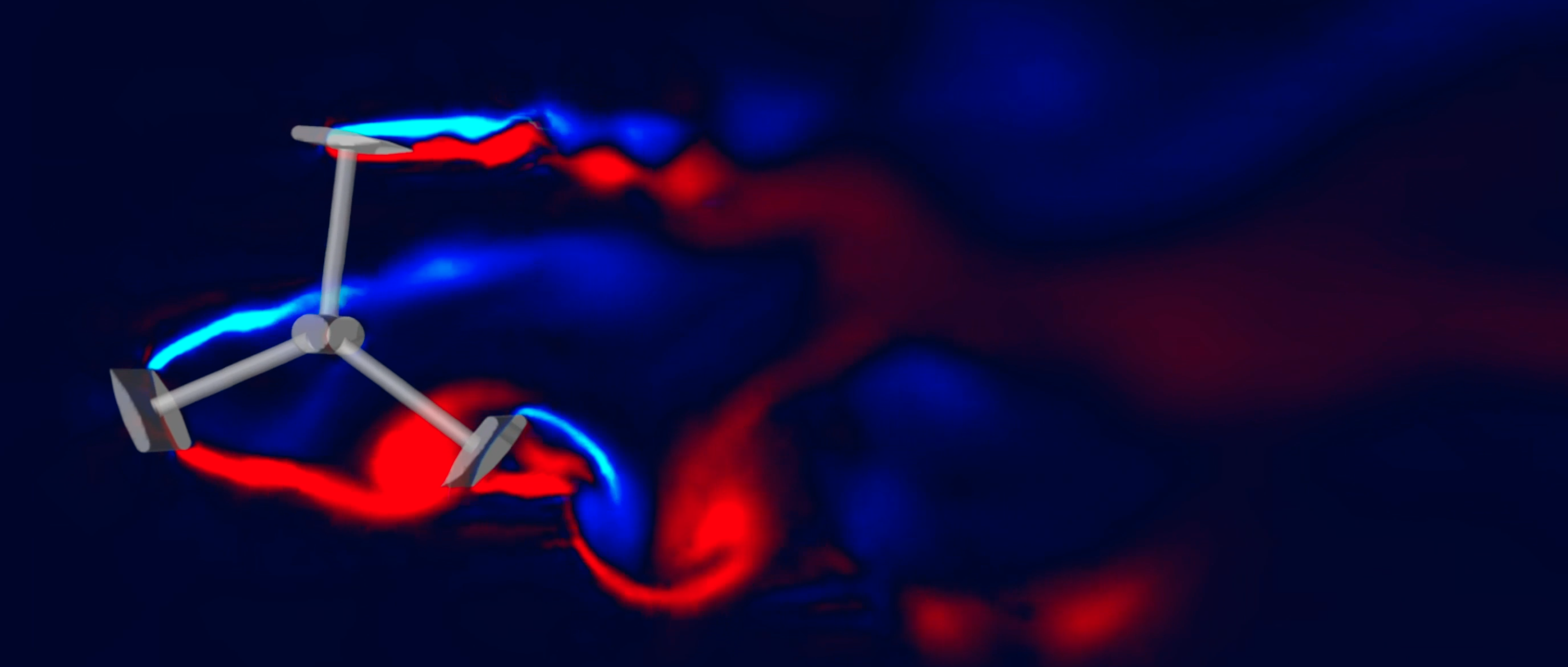
Wind Turbines
With demand for wind energy skyrocketing, it is crucial to design wind turbines optimized for maximum power output, stability, and durability. CFD enables engineers to investigate key aspects of wind turbine design, such as analyzing turbine performance under various conditions, predicting wind and wave loads for offshore wind turbines, and understanding how the wake from one turbine on a wind farm affects power production and mechanical loading of downstream turbines. Wind turbine simulations present a number of challenges, however, from the ever-increasing size of wind turbines to the complex interactions between wind turbines and their environment.
CONVERGE contains a host of features and modeling capabilities that help overcome the challenges associated with wind turbine simulations*, including fully autonomous meshing, a broad range of well-validated physical models, and the ability to simulate many complex phenomena in a single simulation.
Actuator Line Model
Wind turbine CFD simulations are inherently expensive due to the complex flow associated with rotating blades, the fine mesh resolution required to accurately capture this complex flow, and the large disparities in time and length scales. The actuator line model (ALM) simplifies the 3D blade geometry to a 1D line. This method significantly speeds up wind turbine simulations, while still accurately capturing essential 3D flow structures. CONVERGE’s ALM includes novel approaches for velocity sampling and force projection, which further increase its accuracy and efficiency. ALM can be used for horizontal- and vertical-axis wind turbines, and the model has been thoroughly validated for both cases.
Onshore Wind Turbines

Historically, wind farms have been built in areas with relatively flat terrain. Recently, however, interest has been growing in placing smaller-scale wind turbines—often vertical-axis turbines—in urban areas, such as in public city squares or on building rooftops. To determine the best locations to place wind turbines in urban areas, you need to understand how buildings and other obstacles affect airflow patterns and, thus, the potential power output of the wind turbines. Even in rural areas, hills, trees, buildings, and other structures alter the flow field in possible wind farm locations. With fully autonomous meshing, CONVERGE makes it easy to incorporate these obstacles into your simulation and observe their influence on flow patterns and power generation. You can use CONVERGE’s fixed mesh embedding to include a refined mesh around obstacles of interest, and Adaptive Mesh Refinement (AMR) to automatically add and remove cells during the simulation to efficiently resolve the important flow phenomena.
Offshore Wind Turbines
CONVERGE offers a complete package for simulating offshore wind turbines, including realistic wind and wave generation, several approaches for coupling wind-wave fields with ALM, and an efficient model for simulating mooring cables. With this package, you can study important phenomena such as power generation under different wind-wave conditions and the stability of offshore wind turbine support structures.
Wind and Wave Simulations
To investigate wind and wave loading on offshore wind turbines, you first need to generate realistic wind and waves fields. In CONVERGE, the wave generation and synthetic turbulence generation tools allow you to easily simulate regular or irregular 3D waves and introduce realistic turbulence into the wind and wave fields. Since the wind affects the dynamics of the waves and vice versa, CONVERGE features robust volume of fluid (VOF) modeling, complete with several interface capturing schemes, to resolve the wind-wave interactions.
Floating Wind Turbines
CONVERGE includes two methods for simulating the interactions between wave fields and floating offshore wind turbine platforms: the kinematic approach and fluid-structure interaction modeling. Both approaches can be coupled with ALM to study the system as a whole in a single simulation.
The kinematic approach determines the motion of a floating wind turbine based on the shape of the waves. This approach does not require calculating the forces on the platform, which makes it computationally efficient. The kinematic approach is thus an excellent method for simulating offshore wind farms containing multiple turbines.
For a higher-fidelity approach, CONVERGE offers fluid-structure interaction (FSI) modeling. This method applies the forces from hydrodynamic loading, solved via CONVERGE’s VOF modeling, and calculates how those forces affect the motion of the wind turbine platform. As FSI simulations of systems with similar fluid and solid densities can become numerically unstable, CONVERGE provides implicit FSI modeling to maintain solver stability when simulating floating platforms.
Mooring Model
In the real world, floating offshore wind turbines are constrained by mooring cables. The mooring model in CONVERGE employs a finite segment method to efficiently calculate the applied forces from the mooring cables, which are then used in the FSI simulation.
Fixed-Bottom Wind Turbines
Fixed-bottom wind turbines, used at shallow and intermediate water depths, must have support structures capable of withstanding significant wave loads. CONVERGE’s FSI modeling allows you to accurately predict the forces imparted by different types of waves to ensure the stability of the support structure.
Heat Transfer in Gearboxes
As the power generation capacity of wind turbines increases, so does the thermal load experienced by the gearbox. With CONVERGE’s conjugate heat transfer (CHT) modeling, you can monitor the temperature of the gearbox during normal operation and simulate a variety of cooling methods, including air cooling and oil cooling. Due to the disparate time scales of heat transfer between solids and fluids, CHT calculations can be expensive. CONVERGE features a CHT timescale management method called super-cycling which substantially reduces time to solution.
*Note that some of these features and models are currently implemented in CONVERGE as user-defined functions.






